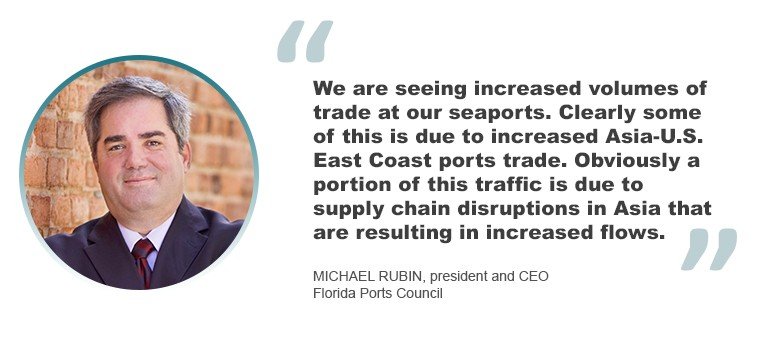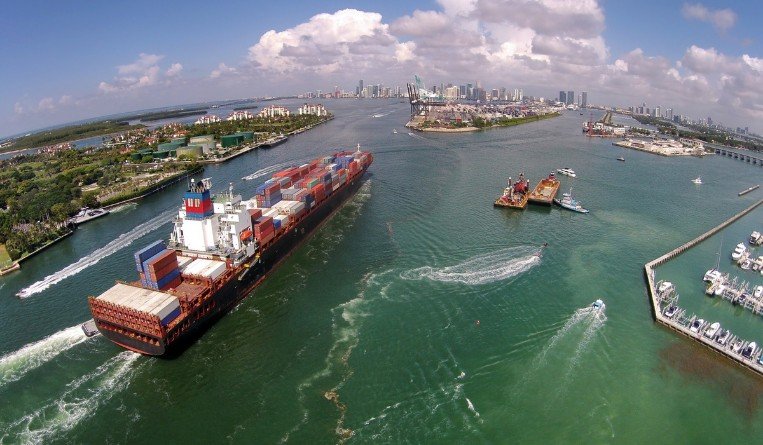Ports in Florida are seeing increased cargo volumes, including from Asia, which an industry body attributes to supply chain disruptions and ongoing congestion issues at U.S. West Coast ports.
Michael Rubin, president and CEO of Florida Ports Council said ports in the state — which include Canaveral, Everglades, Fernandina, Fort Piece, JAXPORT, Key West, Mana6189tee, Miami, Palm Beach, Panama City, Pensacola, Port St. Joe, St. Petersburg and Tampa Bay — are seeing “record months” of container traffic.
“We are seeing increased volumes of trade at our seaports. Clearly some of this is due to increased Asia-U.S. East Coast ports trade,” the Tallahassee-based Rubin told Asia Cargo News, noting that increased container and bulk trade are also boosted by exports to other regions through Florida seaports.
“Obviously a portion of this traffic is due to supply chain disruptions in Asia that are resulting in increased flows,” he added.
The Florida Ports Council chief said East Coast ports are currently a “more efficient” option for shippers considering congestion, delays and backlog issues at major ports in the West Coast including in the ports of Los Angeles and Long Beach, which are the biggest recipient of cargo from Asia.
“We have promoted our seaports as a better and more efficient route to many areas of the U.S., Caribbean and other areas than the use of West Coast ports. Given the seaport and landside issues facing the West Coast, Florida seaports remain a more efficient option for many shippers and beneficial cargo owners,” Rubin said.
Ports in Florida are also pushing to attract trade with Asia by upgrading their capabilities — including deep water berth projects as well as infrastructure to be able to move cargo around the U.S. more efficiently.
“We continue to invest in cargo and logistics capacity at our seaports,” Rubin told Asia Cargo News. “We will have three seaports on the East Coast with deeper vessel capacity to handle more post-Panamax vessels.” Those ports are Miami, Everglades and Jacksonville.
“Florida also continues to invest in off-port logistics and road capacity to move cargo more efficiently into and out of the state,” he added, although noting how “mindset and contracts” are preventing shippers from diverting to East Coast ports.
“Many of these shippers have used West Coast ports for so long, I wonder if they have the ability to see other opportunities. In addition, some have no financial incentives to seek other options, even with delays resulting in multiple weeks of vessels moored offshore,” Rubin said.
Compared to ports on the West Coast, East Coast ports – which include the Florida ports – are less congested, according to Rubin.
“The water transportation costs will always provide a cheaper and more efficient way to move cargo to the eastern/middle of the U.S. Shippers and BCOs are already seeking a more efficient and cost-effective way to move their goods,” he added.
The Florida Ports Council executive noted that they are also already seeing delays, congestion and capacity shortages in the supply chain moving to the peak season.
“We all are seeing these supply chain issues,” Rubin said. “[It’s] going to get worse with the holiday season around the corner.”
Moving forward, he noted that elevated cargo volumes will continue for the rest of the year through next year.
“I think the increased cargo numbers will remain, and we should see record years in both 2021 and 2022,” Rubin said, adding that persisting issues in the West Coast also present an opportunity for ports in the East Coast.
“We see the current issues on the West Coast as an opportunity to promote the efficiencies and savings provided by Florida seaports.”

Charlee C. Delavin



